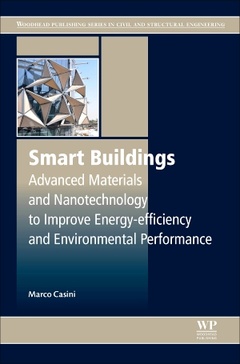Smart Buildings Advanced Materials and Nanotechnology to Improve Energy-Efficiency and Environmental Performance
Auteur : Casini Marco

Smart Buildings: Advanced Materials and Nanotechnology to Improve Energy Efficiency and Environmental Performance presents a thorough analysis of the latest advancements in construction materials and building design that are applied to maximize building efficiency in both new and existing buildings.
After a brief introduction on the issues concerning the design process in the third millennium, Part One examines the differences between Zero Energy, Green, and Smart Buildings, with particular emphasis placed on the issue of smart buildings and smart housing, mainly the ?envelope? and how to make it more adaptive with the new possibilities offered by nanotechnology and smart materials.
Part Two focuses on the last generation of solutions for smart thermal insulation. Based on the results of extensive research into more innovative insulation materials, chapters discuss achievements in nanotechnology, bio-ecological, and phase-change materials. The technical characteristics, performance level, and methods of use for each are described in detail, as are the achievements in the field of green walls and their use as a solution for upgrading the energy efficiency and environmental performance of existing buildings.
Finally, Part Three reviews current research on smart windows, with the assumption that transparent surfaces represent the most critical element in the energy balance of the building. Chapters provide an extensive review on the technical features of transparent closures that are currently on the market or under development, from so-called dynamic glazing to bio-adaptive and photovoltaic glazing. The aesthetic potential and performance limits are also be discussed.
Introduction
Part I SMART BUILDINGS 1. Designing the third Millennium's buildings 2. Advanced materials for architecture
Part II SMART INSULATION 3. Building Insulating materials 4. Advanced insulating materials 5. Phase Change Materials (PCMs) 6. Advanced building skin
Part III SMART WINDOWS 7. Advanced Insulation Glazing 8. Light and solar control glazing and systems 9. Dynamic glazing 10. Energy generating glazing
Industry professionals, engineers and architects wanting to keep up-to-date with the most recent developments in the building industry; postgraduate engineering and architecture students wanting to expand their knowledge on advanced works and technological solutions; public administration and authority technicians.
experience in Building Sciences. He is an environmental engineer with a PhD in environmental engineering and
is Associate Professor in the Department of Urban Planning, Design and Technology of Architecture at Sapienza
University of Rome, Italy, where he also teaches in several Masters, PhD, and Graduate schools on subjects
pertaining to energy and environmental sustainability for buildings.
His area of expertise concerns sustainable architectural design and construction, focusing on advanced materials,
technologies, and strategies for smart buildings and smart cities. His professional activities include international
scientific and technical consultancy on technological, environmental, and energy aspects related to the design
and construction of high-performance buildings, as well as training on Green Building and Smart Cities strategies
and policy-making for public authorities.
- Presents valuable definitions that are given to explain the characteristics, requirements, and differences between ‘zero energy’, ‘green’ and ‘smart’ buildings
- Contains particular focus on the next generation of construction materials and the most advanced products currently entering the market
- Lists both the advantages and disadvantages to help the reader choose the most suitable solution
- Takes into consideration both design and materials aspects
- Promotes the existence of new advanced materials providing technical information to encourage further use and reduce costs compared to more traditional materials
Date de parution : 06-2016
Ouvrage de 384 p.
15x22.8 cm
Thèmes de Smart Buildings :
Mots-clés :
3D house printing technology; Adaptive envelope; Advanced building materials; Advanced insulating materials; Advanced insulation glazing; Advanced low-emission glazing; Advanced pitched roofs; Advanced shading systems; Advanced window frames; Aerogel; Antireflective glazing; BEMS; Bioadaptive facades; Biobased insulating materials; Building heat capacity; Building insulating materials; Building integrated photovoltaics; Cool roofs; Dye-sensitized solar cells (DSSCs)Glass�glass photovoltaic (PV) glazing; Dynamic glazing; Dynamic shading systems; Electrochromic (EC) glazing; Energy-exchanging materials; Environment-adaptive skin facades; Ethylene tetrafluoroethylene (ETFE)Fire-resistant glazing; ETICS; Glazed double-skin facades; Global transmission factor; Green building materials; Green building rating systems; Green building; Green walls; Heating glazing; HEMS; Internet of things; Latent heat storage; Light redirection systems; Living wall; Monolithic aerogel insulating glazing; Nanomaterials; Nanoporous insulating materials; Nanotechnology; Optical systems; Organic PV (OPV)Prismatic optical cell PV glazing; Phase-change materials (PCMs)Thermal mass; Photochromic glazing; Polymer-dispersed liquid crystals (PDLCs)Smart windows; Property-changing materials; PV windows; Reflective coatings; Selective glazing; Self-cleaning glass; Semitransparent PV (STPV) thin films; Smart building; Smart materials; Solar protection glazing; Spherical cell PV glazing; Suspended film glazing; Suspended particle devices (SPDs)Thermochromic glazing; Thermal reflective coatings; Thermal resistance; Transparent insulating materials; Transparent luminous solar collectors; Transparent OLED windows; Urban heat island (UHI) effect; Vacuum insulating glass (VIG)Vacuum insulating panels; Ventilated walls; Zero-energy building


